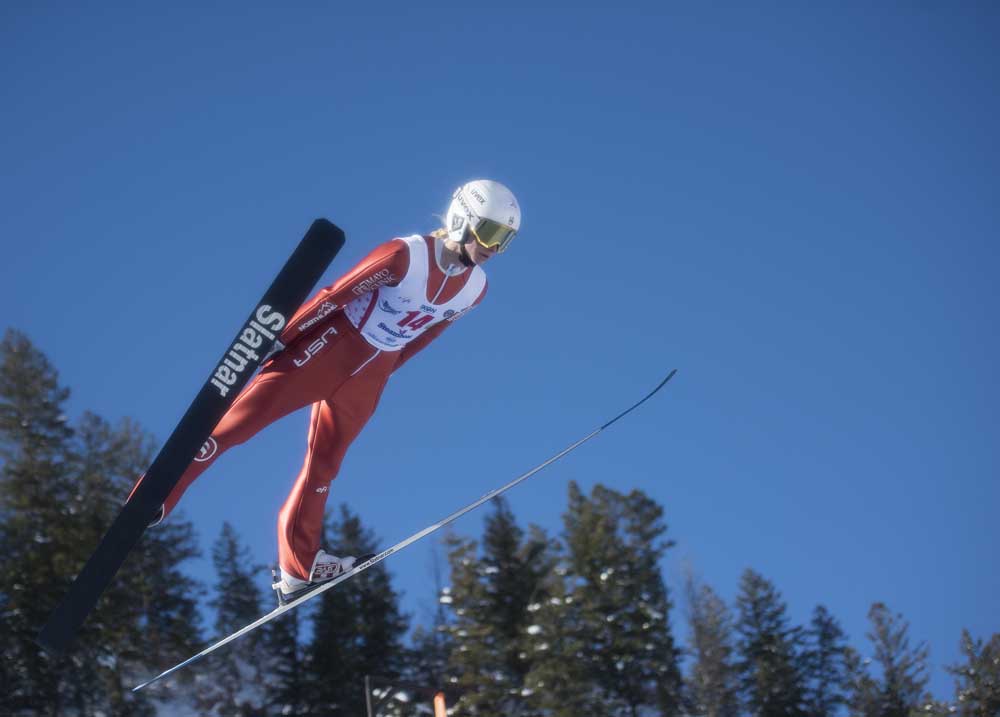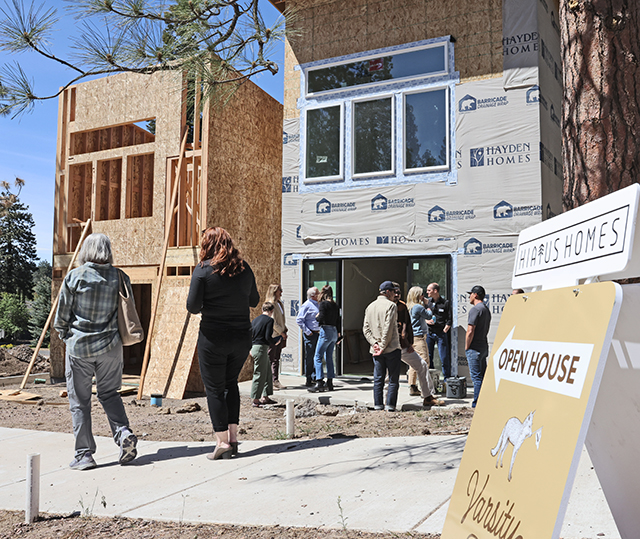Women’s nordic combined struggles to take off
Published 12:00 am Monday, December 31, 2018

- Tara Geraghty-Moats competes in the ski jumping portion of the Nordic combined Continental Cup competition in Steamboat Springs, Colo., Dec. 15, 2018. Women's Nordic combined athletes were supposed to have their shot at Olympic glory in 2022. Now 2026 looks more likely as the sport tries to reach a critical mass of quality. (Joel Reichenberger/The New York Times)
STEAMBOAT SPRINGS, Colo. — Tara Geraghty-Moats was 11 the first time she took a big trip for a ski competition. Her mother insisted she was still too young to travel with a team, so the pair set off from Vermont, boarded a plane and flew to Steamboat Springs for the 2005 ski jumping and nordic combined Junior Olympics.
She was so excited at the opportunity to compete in a national nordic combined event that she had personal-best days on both sides of the sport: cross-country skiing, where she finished the 5-kilometer race so quickly that she did not beat her time again until she was 18, and ski jumping, where she summoned the courage to fly from one of the complex’s big jumps for the first time.
“I didn’t even know enough to be scared,” she said. “That was such an awesome week.”
Nearly 14 years later, again in Steamboat Springs, Geraghty-Moats struggled to stay upright after yet another big breakthrough. She planted her ski poles in the snow and leaned into them before looking up with a wide, bright grin on a dark, cold night. Emotions swirled, joy and relief mixing at the finish line for the first senior international women’s nordic combined competition ever contested on North American snow.
She had waited so long for this, and she won big, by 47.7 seconds. That, in some ways, is not actually a good thing.
Nordic combined is the only Olympic sport, summer or winter, without a women’s division. That is expected to change at some point, but not everything that night in Steamboat Springs gave the impression of an event ready for the spotlight.
Geraghty-Moats, 25, won by topping a field of only 14 athletes.
Some were a decade younger than her, and others entered the competition having barely practiced. Skiers finished five, seven and even 11 minutes off the pace, an eternity for a 5K. That disparity in talent kept packs from forming, so most athletes raced alone on the dark course, its far, cold corners lit dimly by small banks of LED lights powered by gas generators.
The fewer than 150 fans who were there largely stayed huddled close to a smoky bonfire near the finish line. It smoldered beneath the nearly empty stands of a rodeo arena converted in winter for ski races. Many who did show up were there primarily to watch a concurrent men’s competition.
Still, women’s nordic combined is going somewhere.
The hope from international organizers was to have it in the next Olympics, in 2022 in Beijing. But four years into a plan to fast-track the sport’s growth, the schedule has been derailed, prompting questions about what sports belong in the Olympics, and when they should be added.
Nordic combined has been a part of the Winter Olympics since the first games, in 1924 in Chamonix, France — longer than signature events such as alpine skiing and, by 74 years, snowboarding. The sport had always been limited to men at the international level, but while there never was a future in nordic combined for girls, there have always been girls in nordic combined, for a while at least.
When boys in the sport became teenagers, they could start to dream of competing at a World Cup event or even making it to the Olympics. Girls, however, had to start looking for something else to do.
“Nordic combined was No. 1 for me, but all the coaches, whether they were cross-country coaches or ski jumping coaches, they just looked at me and said, ‘You have to choose,’” Geraghty-Moats said.
With no Olympic future to dream of, many teenage girls focused on one side of the sport while others opted out of the lifestyle entirely.
Those who lingered found diminishing returns. The competition Geraghty-Moats traveled across the country for in 2005, the premier event that season, had only six girls in it. Smaller events often could not muster even the two needed to make a race.
“It would get boring,” Meaghan Reid of Canada said. “I’d win Canadian Nationals every year because I was the only one in my age group. I just had to finish the race.”
FIS, the global governing body for skiing, has been trying to change that. The goal has been to create a wave of competitors ready for the big time. There have been international youth events since 2014. Last season featured a test event at the Nordic World Junior Ski Championships, and this season will have a full event there, the first world championship ever awarded in the sport.
Those events have drawn strong participation, often more than 30 athletes.
Efforts to start a senior circuit have not gone as well. A Continental Cup series, the precursor to a World Cup, was started last winter. Geraghty-Moats missed it with an injury. Nineteen athletes showed up for four European events, but never more than 13 at a time.
To cap it all, the International Olympic Committee decided during the summer to leave women’s nordic combined off the program for the 2022 Olympics. The next chance is 2026, an event so far out that it has not yet been awarded to a host city.
“Would the sport have been ready for 2022? We’ll never know,” said Lasse Ottesen, the FIS nordic combined race director. “It was a very aggressive goal from our side.”
He added that 2026 was the new goal, “and we will definitely be ready.”
The women’s nordic combined Continental Cup has returned this winter with a more robust schedule, with 11 events, including four earlier this month in the United States: two in Steamboat Springs and two in Park City, Utah.
The competitors came from nine nations and fit into two categories.
Some, like Veronica Gianmoena of Italy, 23, came back to nordic combined after years away. She competed until she was 14, giving it up when she qualified for the Italian ski jumping team. She hurried back two years ago when the first Continental Cup events came on the horizon.
Reid, from Canada, is finishing her master’s degree and applying for medical school, nine years removed from nordic combined. She wanted to try an international event, however.
“I would have killed for this opportunity 10 years ago,” she said.
Others, like Gyda Westvold Hansen of Norway and Jenny Nowak of Germany, who are both 16, are arriving at the perfect time. They never had to decide how long to stick with a futureless sport. Instead, they have been competing in youth events for several years.
Their experience is evident. Hansen placed second in both Steamboat competitions and won once in Park City. Nowak won the junior worlds test event last season and was second in both Park City events this month.
They are the leading edge of the wave organizers hoped to build. Seven of the 14 athletes competing in Steamboat Springs were teenagers, including two from the United States: Tess Arnone, a 15-year-old who has long dreamed of nordic combined glory, and Annika Malacinski, 17, who was drawn to the sport by its new potential. Then there is Geraghty-Moats.
A twisting road of injuries and tough decisions had Geraghty-Moats focusing on cross-country skiing, biathlon and ski jumping in different seasons. But now training with the ski jumping and the nordic combined teams with USA Nordic, it all prepared her to fly far on a cold day and ski fast through a dark night in Steamboat Springs. She won all three Continental Cup events she entered this month in the United States, but the first stood out.
She coasted toward the finish line with her arms spread, taking in a moment she had wanted since she was 11 and in her first big event. It was still more than 2,600 days to the 2026 Olympic opening ceremony, but after waiting so long just to compete in her sport, she was not counting.
“We’ve all chosen a path that isn’t the standard one, and maybe not even the recommended one, but we’re here because we love the sport,” Geraghty-Moats said.
“We don’t have the Olympics as a carrot. We don’t have tons of sponsors or funding or even sometimes a team to train with. It’s amazing to be competing with women who love the sport this much.”






